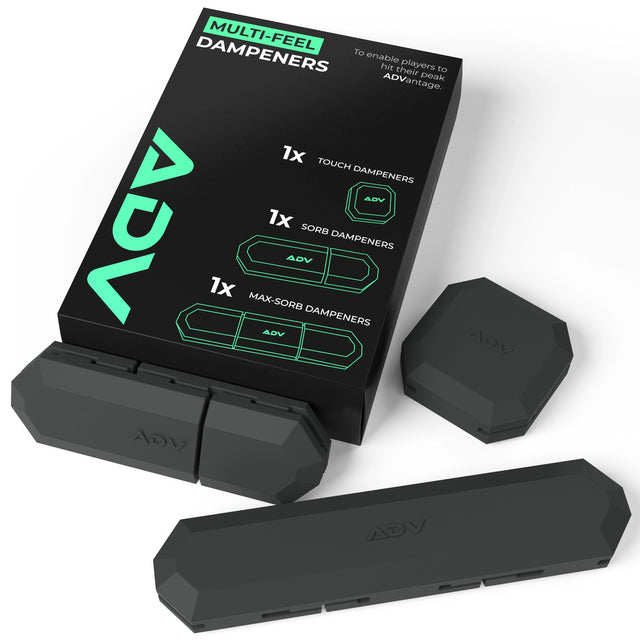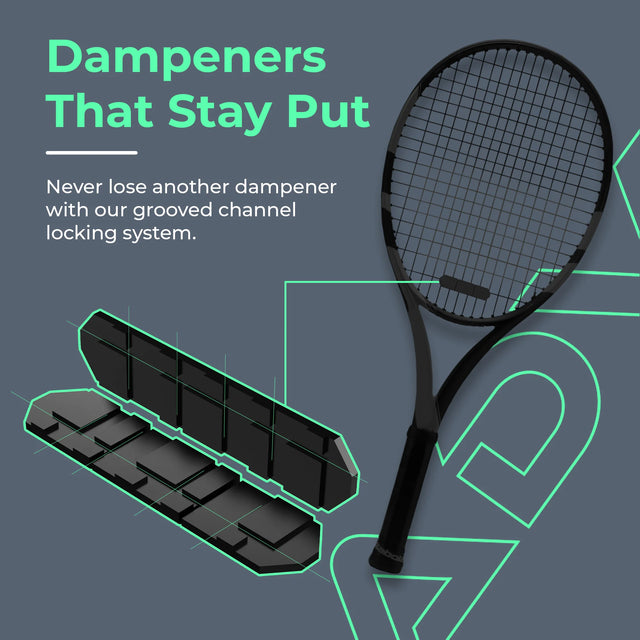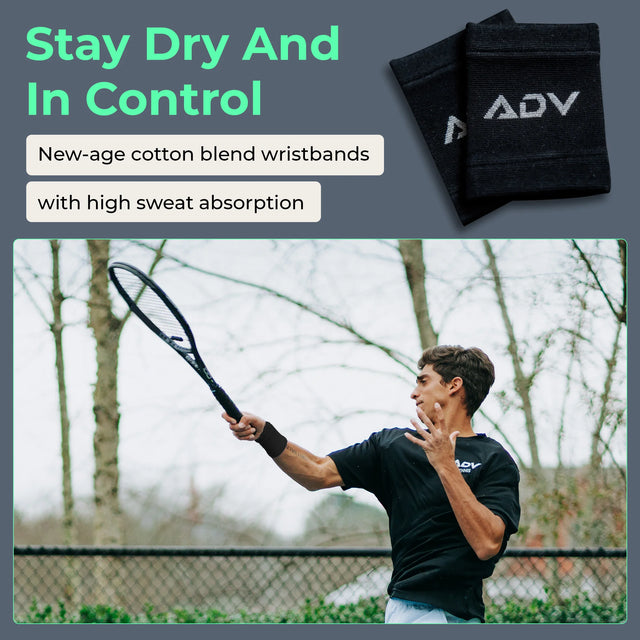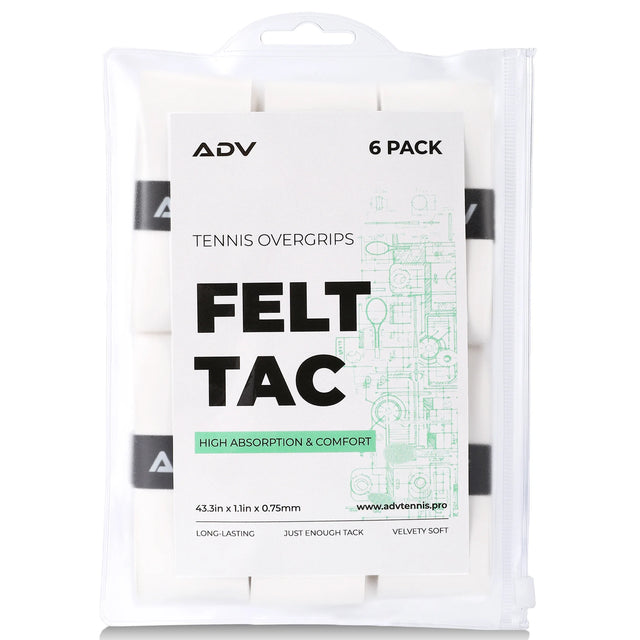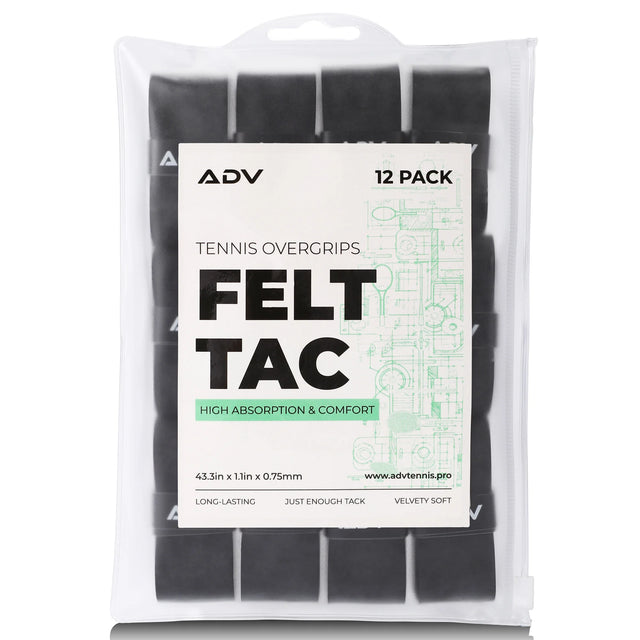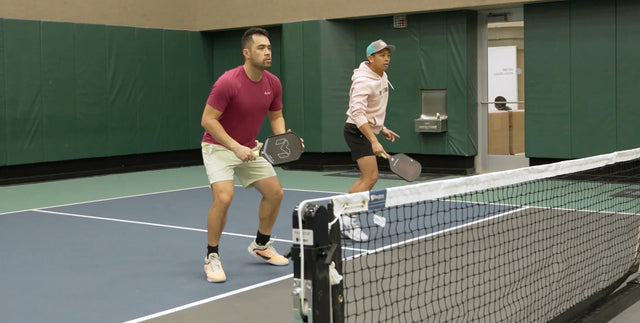Tennis Racket Dampeners: Everything You Need to Know
Tennis racket dampeners are small yet crucial accessories used by players to modify the feel and sound of their rackets during play. These devices are inserted between the strings of the racket to mitigate the vibrations that occur upon ball impact. Dampeners come in various shapes and sizes, each designed to provide a specific level of vibration absorption based on the player's needs and preferences. The use of a dampener for a tennis racket has become a standard practice among both amateur and professional players. The primary tennis dampener benefits include a reduction in the risk of tennis-related injuries, which can occur from repeated stress and vibration to the arm.

Understanding Tennis Racket Dampeners
What is a Tennis Racket Dampener?
As said before, but diving deeper now, a tennis racket dampener is a device specifically designed to absorb the vibrations transmitted through a racket’s strings upon the impact of hitting a tennis ball. These vibrations, if left unchecked, can not only affect the feel of the racket but also potentially lead to discomfort or injury over time. Dampeners are typically made from soft materials like silicone or specialized polymers, which effectively mute high-frequency vibrations, resulting in a more stable and comfortable playing experience. This accessory is straightforward yet impactful in enhancing the mechanical interaction between the racket and the ball.
How Tennis Racket Dampeners Work
The mechanism behind a tennis vibration dampener involves dissipating the kinetic energy generated upon ball contact. By inserting a dampener among the strings, the energy, instead of traveling through the entire string bed, gets localized or absorbed within the dampener’s material. This interaction significantly reduces the vibration felt by the player and diminishes the racket’s ping sound to a more subdued thud. The effectiveness of vibration reduction depends on the dampener’s material density and placement, which can vary based on the racket’s design and the player's sensitivity to vibrations.
Common Misconceptions About Dampeners
Tennis racket dampeners are often surrounded by myths and misconceptions that can mislead players about their true purpose and effectiveness. Understanding what these small devices can realistically achieve helps in making informed choices about using them.
- Power and Spin Myths: One prevalent misconception is that dampeners for tennis rackets can significantly alter the power and spin of the ball. However, their actual function is not to enhance these attributes but to refine the feel and feedback from the racket upon ball contact. They do not directly impact the mechanics of ball spin or power generation during play.
- Feedback Modification: Dampeners primarily modify how the racket feels in your hands upon striking the ball. They are designed to smooth out the harsh vibrations that can lead to discomfort or even injuries. This adjustment can help players achieve a more consistent performance by reducing distractions from racket vibrations.
- Misuse of Makeshift Dampeners: Another common myth is that any rubber-like material can be used as a tennis racket vibration dampener. While makeshift dampeners may provide some level of shock absorption, they are not optimized for this purpose and can sometimes alter the racket's performance unpredictably.
- Performance Integrity: Certified tennis dampeners are engineered to offer vibration dampening without compromising the structural and performance integrity of the racket. Using a specifically designed dampener ensures that the racket continues to perform as expected while providing the added benefit of vibration reduction.
- Universal Benefits: It's also mistakenly believed that the benefits of dampeners are universal for all players. In reality, the perceptible impact of using a dampener can vary widely among individuals based on personal sensitivity to vibrations and specific playing styles.
Understanding these truths about tennis racket dampeners clarifies their role and helps players make better equipment choices tailored to their needs. Dampeners are not a one-size-fits-all solution but a customizable tool that, when used correctly, can enhance the playing experience without altering the fundamental characteristics of the racket.
Impact of Dampeners on Racket Performance
The primary impact of a tennis racket vibration dampener is on the player's sensory experience rather than on the measurable output of the racket. By smoothing out unwanted vibrations, dampeners help players achieve a cleaner feel, which can lead to better control over their shots and reduce the likelihood of developing arm discomfort. While some players might notice a subtle change in the racket's response time or a muted sound upon impact, the actual speed and spin of the ball are generally unaffected by the presence of a dampener.
Benefits of Using Tennis Racket Dampeners
Enhancing Comfort and Reducing Fatigue
Comfort on the court is not just about physical ease but also about sustaining performance levels throughout matches or training sessions. Tennis vibration dampeners help enhance a player's comfort by smoothing out the harsh feedback typically felt when a tennis ball hits the racket. This smoother feedback reduces the jarring shocks that can lead to muscle fatigue, allowing players to maintain a consistent level of play for longer periods. The reduced fatigue also means players can train more effectively, focusing on their technique rather than adjusting their play to avoid discomfort.
Improving Sound and Feel of the Racket
The sound produced when a ball hits the racket strings can be sharp and distracting. A tennis racket vibration dampener alters this sound, producing a muted, more subdued noise that many players prefer. This change in sound is accompanied by an improved feel of the racket, giving players a greater sense of control and finesse during strokes. The psychological benefit of a better-sounding and better-feeling racket can significantly boost a player's confidence and satisfaction, potentially leading to better performance in competitive scenarios.

Impact on Tennis Elbow and Other Conditions
Tennis elbow is a common ailment among players, characterized by pain and inflammation around the elbow joint, often exacerbated by continuous racket vibrations. Utilizing a shock dampener for a tennis racket can mitigate these harmful vibrations, offering a protective barrier against the development of tennis elbow. For players already suffering from this condition, dampeners can make the difference between a painful playing experience and a manageable one. Beyond tennis elbow, dampeners can help in reducing the risk of other overuse injuries, ensuring players can enjoy the game while maintaining their physical well-being.
Types of Tennis Racket Dampeners
Button-Shaped Dampeners
Button-shaped dampeners are compact, designed to fit securely between the intersecting strings near the racket’s sweet spot. This tennis dampener placement optimizes the reduction of vibrations directly where the ball frequently makes contact. The benefit of using these dampeners lies in their subtlety—they moderate vibrations without significantly altering the racket's natural string tension or playing characteristics. Ideal for players who value precision and minimal interference, button-shaped dampeners are a popular choice because they help reduce tennis racket vibration effectively while preserving the original feel of play.
Worm-Shaped Dampeners
Worm-shaped dampeners extend through multiple strings and wrap around them, offering a more comprehensive vibration-dampening effect. This extensive coverage is particularly advantageous for players who experience higher vibration feedback due to their powerful playing style. The string dampener tennis players opt for often depends on their susceptibility to arm fatigue and discomfort; worm-shaped dampeners distribute the impact energy more evenly across the string bed, significantly reducing the shock transmitted to the player’s hand and arm. This type of dampener is favored by those who need robust vibration control and a noticeable reduction in racket feedback.
Customized Dampeners
Customized dampeners go beyond standard solutions, allowing players to achieve a personalized balance between aesthetic appeal and functional performance. Whether fashioned from unique materials or featuring custom designs, these dampeners cater to players' specific preferences for vibration control and feedback. Players can choose designs that concentrate dampening effects in particular areas of the string bed, tailoring the feel according to their playing habits and physical requirements. The best tennis racket dampener for any player often combines personal style with precise functionality, enhancing both the look and the feel of the racket.
Comparing Different Types for Various Playing Styles
Choosing the right dampener involves understanding the unique advantages each type of tennis dampener offers. Players who engage in quick, sharp volleys may prefer the minimal disruption of button-shaped dampeners, while baseline players generating more force might benefit from the extensive vibration control provided by worm-shaped dampeners. Customized dampeners can be particularly beneficial for competitive players who have very specific needs related to the balance, weight, and feedback of their racket. Each dampener type offers distinct benefits, and the optimal choice depends heavily on a player's individual sensitivity to vibration, playing style, and personal comfort preferences.
Maintenance and Replacement of Dampeners
After each session, remove the dampener and gently wipe it with a damp cloth to clear away sweat, dust, and debris that can accumulate and affect its performance. For a deeper clean, use mild soap and water, then allow it to air dry completely before reinstalling. Avoid harsh chemicals or abrasive materials that could degrade the dampener’s surface. When not in use, store your dampener in a cool, dry place, away from direct sunlight or extreme heat, as prolonged exposure can weaken or deform the material. Periodically inspect your dampener for signs of wear, such as cracks, loss of elasticity, or deformation. Replace it promptly if you notice any damage or a decline in vibration absorption to maintain consistent comfort and protection during play. Proper care extends the life and effectiveness of your dampener.
How to Choose the Right Tennis Racket Dampener
Factors to Consider: Material, Size, and Shape
Choosing the right tennis racket dampener involves a nuanced understanding of the dampener's material, size, and shape, as these factors directly influence its effectiveness and compatibility with your racket. The material determines the dampener's ability to absorb shock and reduce vibration. Silicone dampeners typically offer a softer feel and can absorb shock effectively, making them suitable for players who experience discomfort from racket vibrations. Rubber dampeners, on the other hand, tend to be stiffer, providing a more subtle dampening effect favored by players who do not want to significantly alter the feel of their racket.
The choice of material in a tennis racket dampener significantly affects its performance. Silicone is renowned for its flexibility and excellent vibration-absorbing qualities, making it a popular choice for players looking for maximum comfort. Rubber, while slightly less flexible than silicone, is durable and offers a firmer feel, preferred by players looking for stability in their strokes. Some dampeners also incorporate advanced composite materials that combine the benefits of both silicone and rubber, offering durability and superior vibration-damping.
Popular and Recommended Dampener Products
There are commonly recommended dampener brands and models. When it comes to choosing a tennis racket dampener, several consistently stand out due to their popularity. Players should evaluate the material, shape, and installation method of each dampener, as well as user reviews and testimonials regarding durability and performance. Many players find value in trying a few different models to determine which best suits their comfort and performance needs. Ultimately, the best dampener is one that aligns with your playing style, reduces unwanted vibrations effectively, and enhances your overall experience on the court.
Evaluating Your Playing Style and Needs
Selecting the right tennis dampener rests significantly on a thorough understanding of your personal playing style and specific needs. This understanding ensures that the dampener you choose enhances your performance and comfort, tailored to how you play and what you require from your equipment.
- Intensity of Play: Consider the intensity and frequency of your matches. Players engaged in high-intensity competitive play often require dampeners that provide substantial vibration reduction to cope with the vigorous impact and minimize fatigue and injury risks.
- Sensitivity to Vibration: Assess your sensitivity to vibration. Players who are particularly sensitive or have experienced injuries related to racket vibrations, such as tennis elbow, might find greater benefits from a dampener that offers robust vibration absorption.
- Preference for Feedback: Determine your preference for racket feedback. Some players prefer a dampener that preserves the natural feel and feedback of the racket, offering a more subtle dampening effect that allows for precision and nuanced control during play.
- Frequency of Play: Reflect on how often you play. Regular players, especially those who train frequently or compete, might prioritize durability and a more pronounced dampening effect to endure the repetitive stress and reduce wear and tear on the body.
- Type of Matches: Think about the types of matches you typically engage in. Recreational players may opt for a lighter dampening effect compared to serious competitive players who might need more robust vibration control to maintain performance over long and demanding matches.
By evaluating these factors, you can make a more informed decision when choosing a tennis dampener that best fits your playing style and meets your needs. This approach not only enhances your comfort and effectiveness on the court but also helps in prolonging your playing career by mitigating potential injuries.

When choosing a tennis dampener, consider the specific characteristics of the dampeners available and how they align with your needs. Material, size, and shape should be selected based on how they affect the dampener's performance in terms of vibration absorption and impact on the racket's feel. Furthermore, it's crucial to correctly install and position the dampener on your racket to maximize its effectiveness. Placement between the center main strings just below the bottom cross string is typical, but experimenting with placement can help you find the most beneficial position for your style of play. Moreover, regularly evaluate the condition of your dampener and consider replacing it if it shows signs of wear or if you notice a decrease in its effectiveness. Keep in mind that while dampeners are helpful, they are just one part of a comprehensive approach to equipment management and injury prevention. Enhance your comfort and performance on the court with premium tennis racket dampeners from ADV Tennis. Proper technique, adequate physical conditioning, and the right overall racket setup are equally important in ensuring optimal performance and reducing injury risk.


